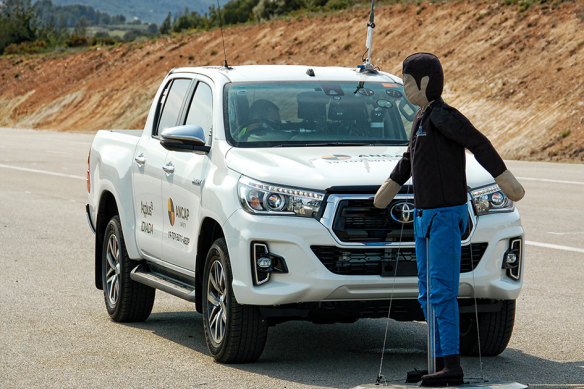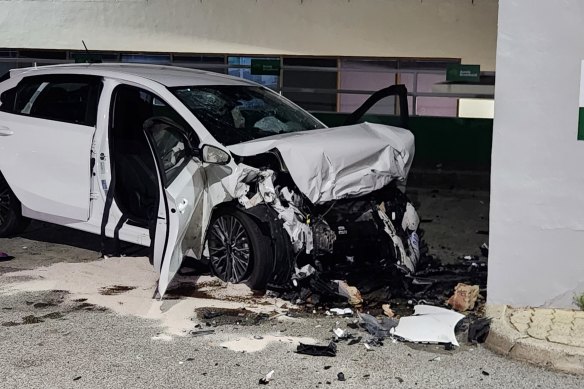Australia’s new car safety standards slipping behind rest of world
Australia’s safety standards for new cars are falling behind the world’s best, as life-saving technology is made compulsory across Europe but remains optional for vehicles sold locally.
Systems that alert motorists when they exceed the speed limit and monitor them for signs of drowsiness and distraction could soon be mandated, however, if shown to be suitable for local roads.

ANCAP testing pedestrian emergency braking, which will be mandatory on all new cars sold in Australia from 2026. Credit: ANCAP
Australia recorded 1266 road deaths in 2023 – the highest number since 2016 – and there are hopes that so-called Advanced Driver Assistance Systems (ADAS) can help reverse that trend.
The European Union made a suite of such safety systems mandatory on all new car models released in July 2022, and will make them mandatory on all new cars (including existing models) sold from July.
That includes Intelligent Speed Assistance, which uses GPS data or sign-recognition cameras to notify drivers of the speed limit, and alerts them if they exceed it; lane keep assist, which intervenes to prevent drivers veering out of their lanes; blind spot detection sensors; and “black box” event recorders.
The Australian government has flagged it is looking at adding those features to its minimum standards for new cars, the Australian Design Rules (ADRs), but is yet to do so.
Automated emergency braking – which detects when a collision is imminent and automatically applies brakes – will be required in all new cars sold in Australia by 2026.
Australasian College of Road Safety chief executive Ingrid Johnston said Advanced Driver Assistance Systems features would gradually become optional on more cars, but needed to be made compulsory before they flowed through the entire vehicle fleet.
“The average vehicle age in Australia is around 10 years,” Johnston said.
“So if you’re waiting a long time before you make things mandatory … then you’re talking about a safety feature appearing today that is not going to be normalised on our roads for 15 or 20 years.”
Johnston said there was now a significant gap between minimum standards for new vehicles in Australia and the EU.
“We need to be making a big effort to have our safety standards be in line with the best safety standards in the world, and we need to be thinking about what we consider to be optional,” she said.
Monash Accident Research Centre director Stuart Newstead said some driver assistance features could be of great benefit, particularly speed-monitoring systems that actually stopped drivers from exceeding the speed limit, rather than simply notifying them they were speeding.
But Australia may not yet have the infrastructure – such as comprehensive GPS coverage and speed limit maps – to support that and other advanced driver technology, and so local evaluation of their benefits was needed before mandating them, he said.
“Quite often our roads don’t have line markings to support Lane Keep Assist, so it’s not going to work,” he said. “So we need to think about regulation plus making sure the supporting infrastructure is there.”
A 2010 NSW government trial of speed assistance technology suggested it could reduce fatalities by 19 per cent if fitted on all cars. A European Commission analysis of the technology estimated it added $300 to $400 to the cost of new cars.
Alongside Australia’s minimum design standards, the Australian New Car Assessment Program (ANCAP) tests most new vehicles and gives them a safety rating out of five stars to advise consumers, including by assessing non-mandatory safety features.
Most new cars achieve a star rating, but ANCAP gave a zero-star rating to two vehicles late last year – the Mahindra Scorpio and the MG 5 – which it said lacked safety features “that have been commonplace in new cars for many years”.

The scene of a crash in Perth, January 2024.Credit: Nine News
A spokesperson for the federal Transport Department said that because Australia imported cars from all over the world, it set its design standards in line with international standards set by the United Nations rather than with one particular market.
“This ensures vehicles with the latest safety technologies can be supplied in Australia at the lowest price,” they said.
“The Australian government is working with our international counterparts to make new international vehicle regulations similar to the requirements in [Europe] to enable Australia to adopt those technologies. These include lane keep assist, driver drowsiness and distraction, and intelligent speed assist.”
Federal Chamber of Automotive Industries chief executive Tony Webber said Australia needed to determine what safety features were suitable and most effective for the local market rather than simply adopt overseas standards.
“We have a natural market response, and we’ve seen that – there’s a raft of safety technology that is in modern cars that wasn’t there 10 years ago, and they continue to evolve. The question is what role will regulation play,” he said.
The Morning Edition newsletter is our guide to the day’s most important and interesting stories, analysis and insights. Sign up here.